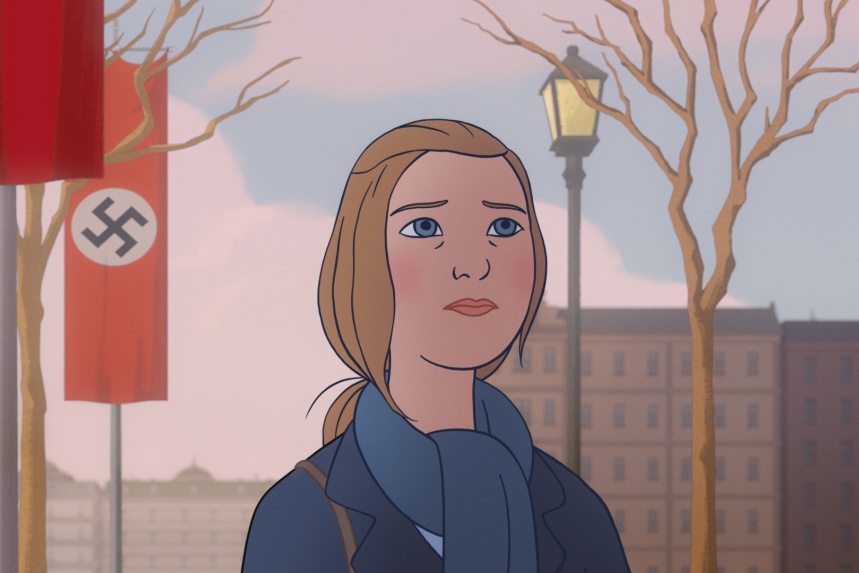Charlotte
⭐⭐⭐⭐
Unrated
Run Time: 1 hour 32 minutes
Stars (Voice): Keira Knightley, Jim Broadbent, Brenda Blethyn
Writers: Erik Rutherford, David Bezmozgis
Directors: Tahir Rana, Éric Warin
Reviewed at the Toronto International Film Festival
In its highest form — if not its most profitable one — the art of animation is more than a mix of color and movement designed to keep the attention of toddlers. Particularly in the case of hand-created animation, moving drawings can make the real seem more real, conveying a film’s subtext in ways live-action cannot.
The story of Charlotte, a hand-drawn film tracing the tragically short yet astonishingly full life of Charlotte Salomon — a Jewish German artist murdered by the Nazis — could have been told with live actors on movie studio sets. That hypothetical film would have been powerful in its own way — how could it not be? But in pen, ink, and paint, co-directors Tahir Rana and Éric Warin have fashioned a haunting dreamscape — sometimes ethereal, mostly achingly realistic — that seems pitch-perfect throughout.
After all, the real Salomon saw the world as an endless inspiration for thousands of color-splashed, dynamic paintings. What better way to look at her world than through her eyes?
Structurally, Charlotte follows the path of a conventional movie biography: We meet Charlotte as an adult, entrusting hundreds of her paintings to a friend, telling him “This is my entire life.” Flashing back to Charlotte’s 1930s Berlin childhood, the film proceeds to explain that plea, and it turns out her words are the literal truth.
In Berlin, Charlotte witnesses, with growing trepidation, the rise of Nazism. Her freestyle painting — not to mention her Jewishness — puts her a odds with the instructors at an art academy. Her expulsion, along with growing violence against Jews, prods Charlotte’s parents to send her to live with her grandparents in the south of France. She’ll be safe there, they think. They are tragically wrong.
Not only does the cloud of murderous racism follow Charlotte to France, but so does another, perhaps even darker, shadow: Virtually every woman in her family has suffered from not only crippling depression, but also eventual suicidal tendencies.
Perceiving deadly threats from without and within (She glumly tells her young lover, “I don’t know how much time I have”), Charlotte embarks on a monumental artistic endeavor: In a small studio, she begins to paint every memory she can conjure up; hundreds upon hundreds of images, some lighthearted — but most depicting visually disturbing nightmares of Nazi atrocities and personal despair.
“Don’t you paint happy things?” her lover asks.
“The sad things seem more real to me,” she answers.
Throughout, the directors linger generously on Charlotte’s paintings — incorporating the artist’s actual works into the animation. The result is a remarkable sense of fluidity: As the “real” world becomes a genuine extension of the paintings, the borders between art and life are blurred, often beautifully; sometimes brutally.
Charlotte comes from the same production studio as the landmark 2017 film Loving Vincent — the first animated movie made with thousands of individual oil paintings. Both films find ingenious ways to explore the psyche of an artist, but while Vincent placed us inside the mind of the painter — whirlpool-shaped stars and all — Charlotte focuses on the regimented, starkly inhospitable world in which the artist found herself, and contrasts it with her wildly imaginative works.
It is no spoiler to relate that Charlotte Salomon was killed at Auschwitz, but not before she secured the safety of her magnum opus, which she called “Life? or Theater?: A Song-Play.” The survival of her work could never constitute a truly happy ending, of course, but Charlotte — bold, colorful, vibrating with life — is a fitting memorial to an indomitable spirit.
Featured image: Good Deed Entertainment
Become a Saturday Evening Post member and enjoy unlimited access. Subscribe now



